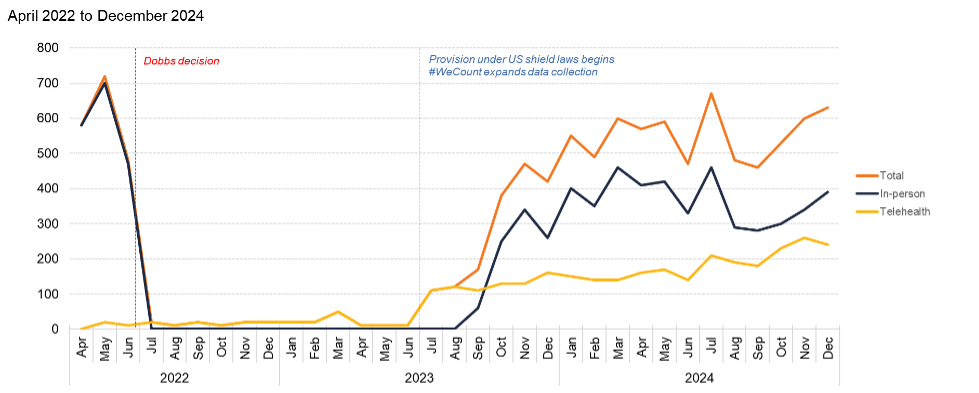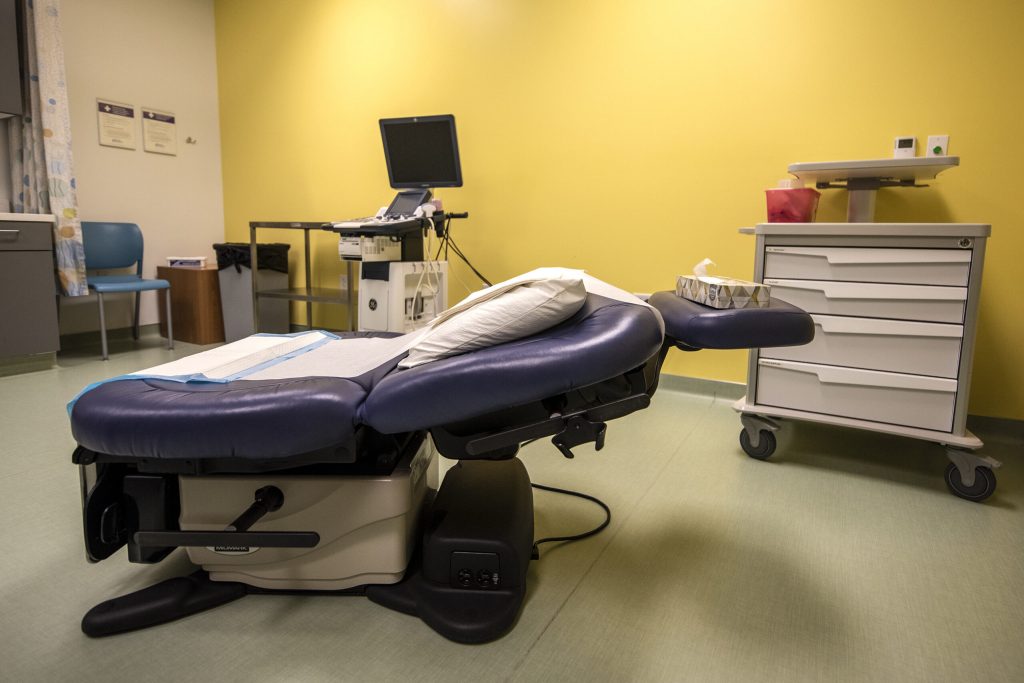New Report Details Post-Roe Abortions in Wisconsin
Three years after Roe v. Wade was struck down, a dramatic shift in the number of abortions has taken place.

Mifepristone. Photo by flickr user Robin Marty. (CC BY 2.0)
The number of abortions in Wisconsin has been rising since late 2023, approaching monthly totals last seen before the U.S. Supreme Court overturned Roe v. Wade, a new analysis shows.
The status of abortion in Wisconsin has seen a series of legal twists and turns over the last three years, and the recently-released “#WeCount” report reflects that shifting landscape.
The report covers data beginning in April 2022 — a few months before the overturn of nationwide protections for abortion — and includes figures reported by health care providers through the end of 2024.
In recent years, abortion in Wisconsin has seen a series of legal twists and turns
On June 24, 2022, the U.S. Supreme Court issued a decision in Dobbs v. Jackson Women’s Health Organization, which overturned the national right to abortion that had previously been established under Roe v. Wade.
Because of the Dobbs ruling, Wisconsin-based providers initially stopped performing abortions. They were worried about being prosecuted under a long-dormant state law, first passed in the mid-1800s. That law makes it a felony for any person “other than the mother” to provide an abortion at any point in pregnancy, and includes an exception only for abortions that are done to save a pregnant woman’s life.

Protesters stand with signs in opposition to the Supreme Court’s decision to overturn Roe vs. Wade on Friday, June 24, 2022, in Madison, Wis. Angela Major/WPR
After Wisconsin’s attorney general sued to block enforcement of that law, a Dane County court ruled in mid-2023 that the 19th century statute did not actually ban abortions. Effectively, that meant abortion was once again legal in the state until 20 weeks of pregnancy.
That lower court decision prompted Wisconsin clinics to resume abortions starting in September 2023. Planned Parenthood was the first Wisconsin organization to restart abortions, beginning on Sept. 18, 2023 at two locations in Milwaukee and Madison.
Since then, a few more clinics have started offering medication and surgical abortions at locations in Wisconsin — and the #WeCount data shows that coincides with a rise in statewide abortion totals.
“In Wisconsin, we are seeing a slow and steady increase since the end of 2023,” said Ushma Upadhyay, a public health and social scientist who helped oversee the #WeCount report.

This graph created by the Society of Family Planning shows the number of abortions reported in Wisconsin from April 2022 through December 2024. Source: #WeCount report, published in June 2025
By October 2023, the month after Planned Parenthood of Wisconsin restarted abortions, the monthly number of abortions in Wisconsin spiked to 380, with roughly two-thirds of those abortions performed in-person.
That’s after the number of in-person abortions in Wisconsin fell to zero in the months after the Dobbs decision, the #WeCount report shows.
By December 2024, the monthly number of abortions in Wisconsin grew to 630, which was roughly on par with the average for the state in the months before the Dobbs decision.
“When you add in telehealth abortions, the total number is pretty close to the total number of abortions before the Dobbs decision,” said Upadhyay, who is a professor at the University of California, San Francisco.
Wisconsinites are using telehealth appointments for abortions
In July of this year, the Wisconsin Supreme Court overturned the state’s 19th century abortion law. That cemented the effects of the Dane County decision, allowing abortion to remain legal in the state until 20 weeks of pregnancy.
And, in Wisconsin, state law requires someone getting an abortion to have multiple in-person appointments with a physician.
That’s in contrast to other states, where providers are allowed to prescribe abortion pills during a telehealth appointment, then give the patient instructions about how to take the pills in the privacy of her own home. Typically, those pills are used to end pregnancies during the first trimester.
In Wisconsin, however, state law requires a prescribing physician be physically present in the room to give a patient abortion medication.
But despite the statewide ban on the practice, data shows that, each month, hundreds of Wisconsinites are still obtaining telehealth abortions.
Under the #WeCount data, in-person abortions include surgical abortions, as well as instances when abortion pills are dispensed at an in-person appointment. Wisconsin’s telehealth abortion numbers reflect instances when someone meets with a provider remotely, and then gets abortion pills delivered through the mail.
#WeCount relies on data reported by medical providers who provide abortions in private medical offices, hospitals and clinics.

The clinic is prepared before patients arrive Friday, May 27, 2022, at Planned Parenthood’s Water Street Health Center in Milwaukee, Wis. Angela Major/WPR
Shield laws in other states aim to protect telehealth abortion providers
In July of 2024, #WeCount expanded its data collection practices for telehealth abortions because of shield laws passed in eight states. Those laws are designed to protect abortion providers from being prosecuted for providing telehealth abortions to patients located in other states, such as Wisconsin, where the practice is illegal.
During December 2024 — the most recent month of available data — 240 Wisconsinites got abortion pills from telehealth appointments, making up 38 percent of Wisconsin’s total number of abortions that month. That’s higher than the percentage nationwide, where roughly a quarter of abortions occur via telehealth, according to #WeCount’s analysis.
“(The percentage of telehealth abortions) tends to be lower in states where there are more abortion clinics that people can go to, and it tends to be higher the more more restrictions in place in a state,” Upadhyay said. “So that tells me that in-person access is still limited (in Wisconsin.)”
At the same, Upadhyay believes the number of telehealth abortions in Wisconsin would rise further if Wisconsin-based providers were able to use remote appointments.
Were medically necessary abortions happening in Wisconsin after Dobbs?
For more than a year — between the Dobbs decision in June of 2022 and the Dane County ruling in mid-2023 — providers across Wisconsin halted abortions because of concerns about the 19th-century abortion law.
But, despite that exception written into state law, the #WeCount data shows zero in-person abortions were reported in Wisconsin from May 2022 through August 2023.
Upadhyay said it’s possible “a very small number” of abortions occurred in Wisconsin under that exception for life-saving abortions, but providers didn’t report those procedures to researchers.
“Many of the hospitals in states with abortion bans have been reluctant to report those, not necessarily because they were not permitted by law, but more just to avoid having to defend the reasons why they provided those abortions,” Upadhyay said.
It’s also likely that, during that time period, Wisconsinites traveled to other states for abortions needed to prevent life-threatening complications, Upadhyay said.
“It’s just easier for them to travel out of state or obtain a telehealth abortion because there are so many legal hoops to qualify for an exception,” Upadhyay said.
What’s not reflected in the new abortion data?
The #WeCount report is limited to data reported by medical providers, and does not include numbers from people who completely self-manage their abortions by turning to home remedies or online abortion pill stores.
Upadhyay believes those numbers are likely to be fairly low.
“I expect this proportion to be pretty small because telehealth abortion is available and sometimes at no cost to people through sites like Plan C, which provides a lot of information about how to access telehealth abortion,” she said.
Wisconsin’s Department of Health Services also releases statistics on abortions in the state. But, unlike the #WeCount report, those statistics do not include telehealth abortions overseen by out-of-state providers.
As required by state law, the department collects data from Wisconsin-based medical providers about the number of abortions those providers induce annually. The department has not yet released reports with data from 2023 and 2024, however.
“We want the datasets to be as complete as reasonably possible before publishing reports,” DHS spokesperson Elizabeth Goodsitt wrote in an email to WPR.
In 2022, a DHS report found that 3,333 abortions were induced in Wisconsin. That’s down from 2021, when the state’s report tallied a total of 6,472 abortions.
How many abortions are taking place in Wisconsin? was originally published by Wisconsin Public Radio.
If you think stories like this are important, become a member of Urban Milwaukee and help support real, independent journalism. Plus you get some cool added benefits.
More about the Overturning of Roe v. Wade
- New Report Details Post-Roe Abortions in Wisconsin - Sarah Lehr - Jul 24th, 2025
- Three Years After the Dobbs Decision, Wisconsin Republicans are Still Trying to Ban Reproductive Freedom - Democratic Party of Wisconsin - Jun 24th, 2025
- On 3rd Anniversary of Roe Being Overturned, Baldwin, Blumenthal, and Murray Lead Senate Dems in a Bill to Restore Abortion Access Nationwide - U.S. Sen. Tammy Baldwin - Jun 24th, 2025
- Support for Abortion Rights Remains Strong in Wisconsin on Third Anniversary of MAGA U.S. Supreme Court Justices Overturning Roe v. Wade - A Better Wisconsin Together - Jun 24th, 2025
- MAGA Wisconsin GOP Pushed to Restrict IVF Access, Reproductive Freedom - Democratic Party of Wisconsin - Feb 27th, 2024
- Families Are Losing Access to IVF Because of Donald Trump - Democratic Party of Wisconsin - Feb 23rd, 2024
- Planned Parenthood Seeks Wisconsin Supreme Court Ruling On Abortion - Hope Kirwan - Feb 22nd, 2024
- PPWI Asks Wisconsin Supreme Court to Protect Abortion Rights - Planned Parenthood of Wisconsin - Feb 22nd, 2024
- Wisconsin Democrats on Donald Trump’s National Abortion Ban - Democratic Party of Wisconsin - Feb 16th, 2024
- How Did Dobbs Decision Affect State’s Birth Rate? - Bridgit Bowden - Jan 2nd, 2024
Read more about Overturning of Roe v. Wade here




















